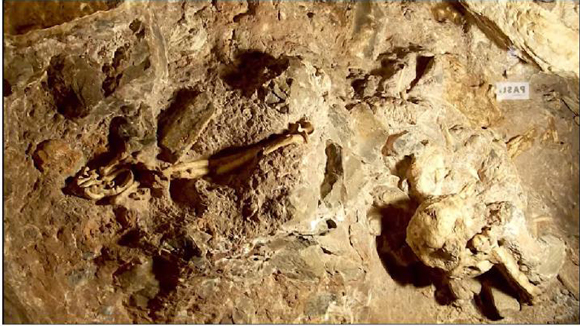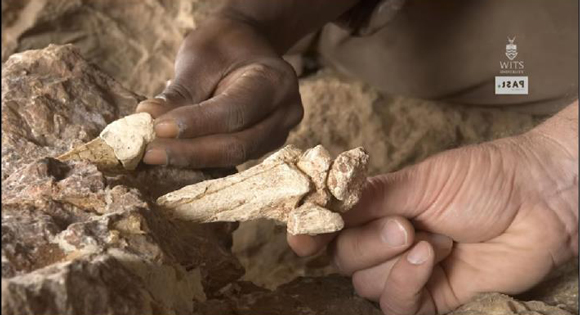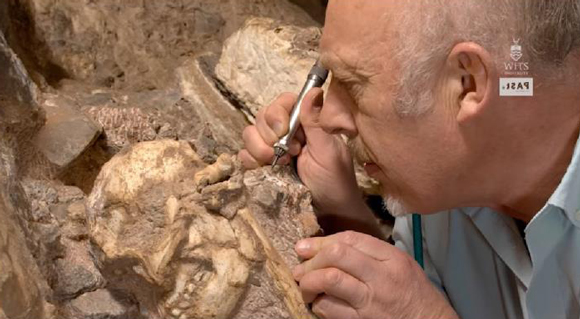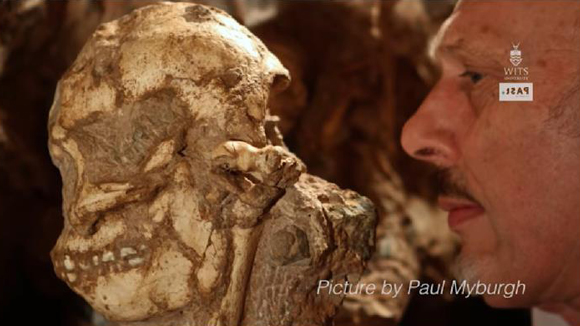Fourteen Years of Work to Tell the Story of “Little Foot”
Christmas is a time for family get togethers and spending time with relatives. Today, we feature the astonishing story of the remarkable and nearly complete fossilised skeleton of an australopithecine nicknamed “little foot” a member of the Hominidae family and as such, a long, distant relative of us all. The Sterkfontein Caves in South Africa are located around twenty-five miles north-west of Johannesburg in Gauteng Province (South Africa).
Numerous fossils of hominids are known from the Caves and the surrounding area, which is called the Cradle of Humankind and Everything Dinosaur has reported on several recent and highly significant australopithecine fossil finds, however, at an estimated 3.67 million years of age, “little foot” is the oldest australopithecine specimen ever found in southern Africa.
The Partially Uncovered Remains of the Australopithecine Nicknamed “Little Foot”

Picture credit: PAST/Paul Myburgh
Lead researcher Professor Ron Clarke and his team have published the first, formal scientific description of the fossil material in the “Journal of Human Evolution”. Such is the completeness of the skeleton, that anthropalaeontologists confidently predict that many more papers will be written, as this is the only known, virtually complete fossil skeleton of an Australopithecus discovered to date. It has taken fourteen years of painstaking work to excavate the fossils and six years to clean and prepare them for detailed study.
Dedicated Research Leads to Scientific Breakthrough
In 1994 and 1997, Professor Clarke identified twelve foot and lower leg bones of one Australopithecus individual misidentified as animal fossils in boxes stored at Sterkfontein and at the University of Witwatersrand (Johannesburg). Clarke and his assistants, Nkwane Molefe and Stephen Motsumi, then looked for and located the very spot where the bones had been blasted out by lime miners, probably sometime in the 1920s deep inside the Sterkfontein Caves. It was a real case of detective work, as Nkwane and Stephen worked in the caves to try to identify the very spot where the fossils that had been stored in the boxes, actually came from.
After one and a half of days of carefully searching the caves, they found that the pieces matched with two broken-through shin bones in a concrete-like cave infill and started the excavation process, first with hammer and chisel to remove the overburden, before turning to the painstaking process of locating and exposing the bones with an airscribe.
The Researchers were Able to Locate the Rest of the Skeleton by Matching Pieces Together

Picture credit: PAST/Paul Myburgh
Unusual Taphonomy of the Female Australopithecine
The taphonomy of “little foot” is unusual. The female (identified by the shape of the pelvis), fell into a cave and the body became mummified in the exceptionally dry conditions. The absence of predators allowed the body to remain undisturbed but at some time in the past there was a slight displacement of some skeletal parts through slippage on the rock-strewn talus slope in the cave, crushing and breaking of some bones through rockfall and pressure, calcification after a change to wet conditions, and then slight downward collapse of part of the cave infill. This partial collapse left voids that were later filled with stalagmitic flowstone that encased breaks through the femurs.
When the first attempts to date the fossils was made, an analysis of the stalagmite flowstone encasing the fossil was made. However, the flowstones were later infills in voids created by the collapse that had broken and displaced parts of the skeleton. The data gave a more recent date for the fossil, “little foot” was actually much older, having lived during the Zanclean stage of the Pliocene Epoch.
Professor Ron Clarke Demonstrates the Use of an Airscribe
Picture credit: PAST/Paul Myburgh
Commenting on the earlier attempts to date the skeleton, Professor Clarke stated:
“The flowstones do not date the skeleton. In 2015, cosmogenic isochron dates using 26Al and 10Be were published in Nature, showing that the age of the actual breccia containing the skeleton dates back ca 3.67 million years. This is consistent with the original age estimates of around 3.5 million years that were proposed based on the low stratigraphic position of the deposit within the cave.”
Helping to Reassess the Australopithecus Genus
Study of the anatomical features of “little foot” suggests that the skeleton is most similar to the australopithecine known as A. prometheus, which was proposed as a species in 1948 by the famous anthropologist Raymond Dart. The phylogeny of the australopithecines and related genera is controversial. It is hoped that the virtually complete skeleton, so painstakingly excavated, will shed new light on taxonomic relationships, helping to fill in a number of evolutionary gaps.
Professor Ron Clarke and the Skull of “Little Foot”
Picture credit: PAST/Paul Myburgh
Everything Dinosaur acknowledges the assistance of a press release from the University of Witwatersrand and supporting materials in the compilation of this article.
Visit the Everything Dinosaur website: Everything Dinosaur.








Leave A Comment